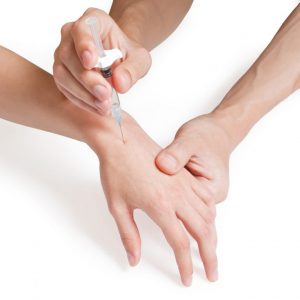Everything you need to know: what is a corticosteroid injection, the effect and side effects.
Many rheumatic conditions are accompanied by painful inflammations in the joints. In most cases, the doctor prescribes NSAIDs to relieve the symptoms. A corticosteroid injection can also be chosen, which is directly put into the joint. In this article, we go deeper into the effect and possible consequences of this treatment.
What are corticosteroids?
Corticosteroids are the chemical equivalent of the adrenal gland hormone. The body-like version is produced by the cortex on the outside of the adrenal glands. This hormone is called cortisol also designated as a stress hormone. After all, it is produced when you face an unwanted and/or dangerous situation. The increased cortisol level provides you with more energy and endurance. This enables you to choose to attack or flee from the threat (fight – fright – flight response). Also when an inflammation arises somewhere in your body, this is considered an unwanted situation. Cortisol then acts as an anti-inflammatory compound. Therefore, corticosteroids as a chemical variety of this hormone are used in orthopedics.
With which conditions do you get a corticosteroid injection?
These injections are given to very specifically treat local inflammations of tendons and joints. The doctor can administer corticosteroids with a wide variety of symptoms for instance: mucous membrane inflammation (Tendinitis), Carpal Tunnel Syndrome, Arthrosis and Rheumatoid Arthritis. A corticosteroid is injected into the cavity of a joint or bursa. With tendon injuries this is done in the tendon sheath or at the location where the tendons are attached to the bone. At this location no blood vessels are present and therefore, high corticosteroid concentrations cannot spread through the body. This compound has therefore only a local effect.
What is the effect of a corticosteroid injection?
It is a big misunderstanding that corticosteroids only suppresseses the symptoms. It is indeed a drug with healing properties. When joints, bursae and tendon sheaths are inflamed, the mucous membrane starts to swell. This might cause tendons and nerves to be compressed. This causes stimulation of the inflammation. In addition, harmful compounds are released which may damage the surrounding tissues.
Corticosteroids have an inhibiting effect on inflammation, which has a relaxing effect on the mucous membranes. When the drug is elaborated, inflammation and swelling will stay away permanently or for a prolonged period of time. Injections with corticosteroids are fast acting and effective with regard to inflammation. Many people already experience an improvement after one week. The pain is decreased and the joint can be moved more flexible. Upon persistent inflammation multiple injections are sometimes necessary. Mostly, not more than four injections per year are given (also see the paragraph on side effects).
How is a corticosteroid injection given?
First of all, the doctor will disinfect the injection site. Consequently, you will receive an injection with an anesthetic. This may be sensitive. Then, the corticosteroids are injected in the joint which you will not feel. The symptoms may temporarily worsen the first 24 hours. Within two weeks, the pain will decrease or disappear. You are allowed to move the joint after the injection.
What are the side effects of a corticosteroid injection?
Some people experience no disadvantages after getting an injection with corticosteroids. Other people may experience pain or itching at the injection site. Other side effects are: swelling, rash and a red discoloration of the skin. A lot of people may experience headache, nausea, fluent feeling, muscle cramps, hoarse voice, hot flashes and vaginal bleeding.
An important side effect of a corticosteroid injection is that it has a negative effect on the remaining cartilage. This is the main reason that repeated injections are not first choice, although they have a very positive effect on the symptoms in a lot of people. The long term Arthrosis will worsen through these injections because the progressive cartilage wear in turn will induce new inflammation. An injection with corticosteroids is therefore an excellent bridge to (for instance) upcoming joint replacing surgery (hip or knee) but is no permanent solution for Arthrosis.

Share this page
Tweet

Download for free the booklet ‘Moving without pain’ with a retail value of $6.75 / £4.95.
Any questions? Please feel free to contact us. Contact us.






